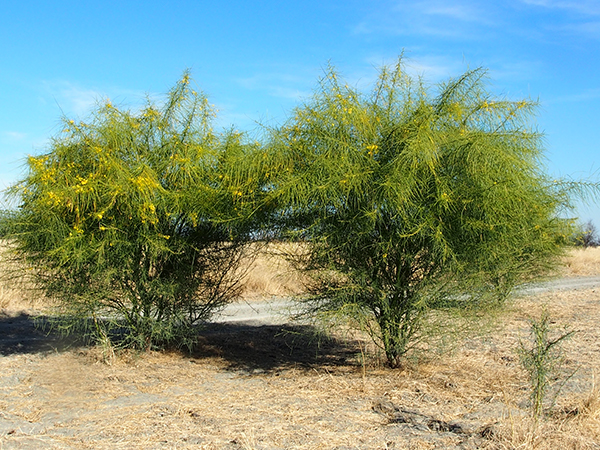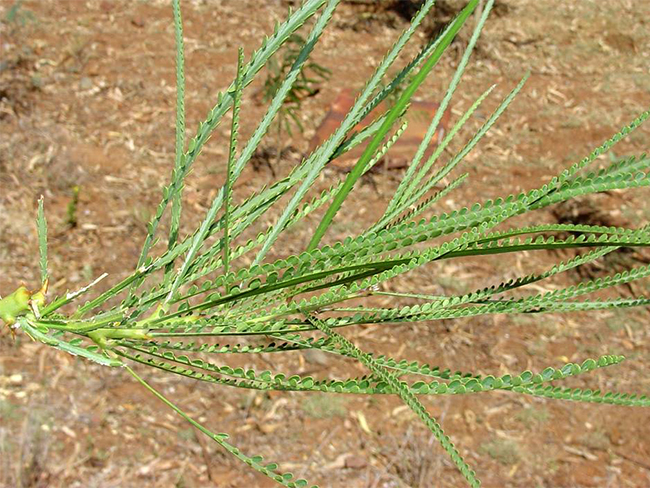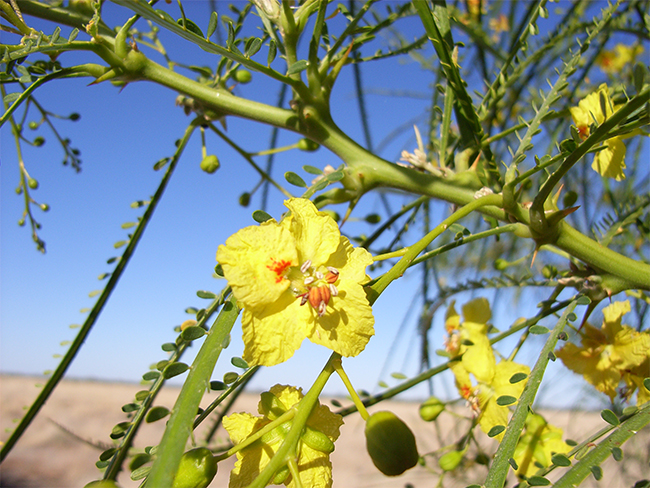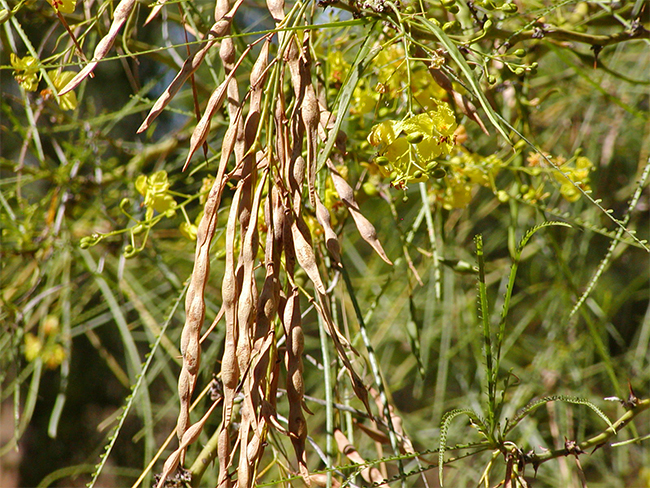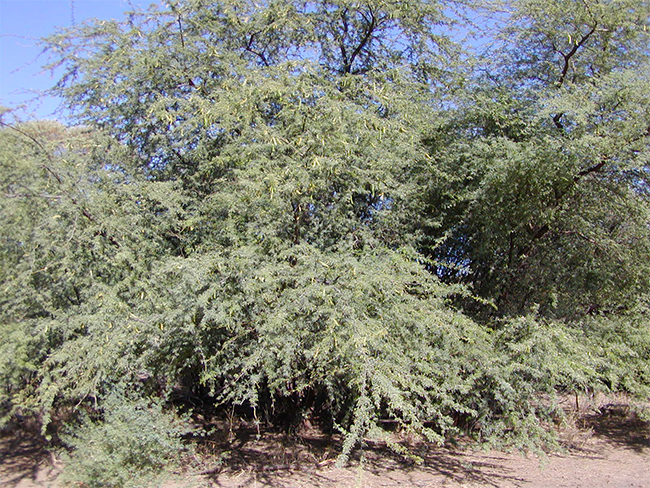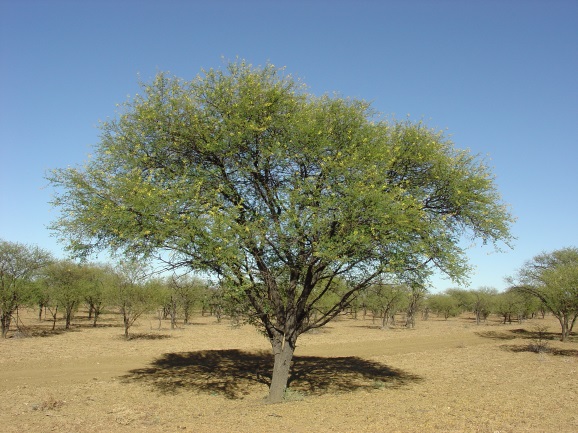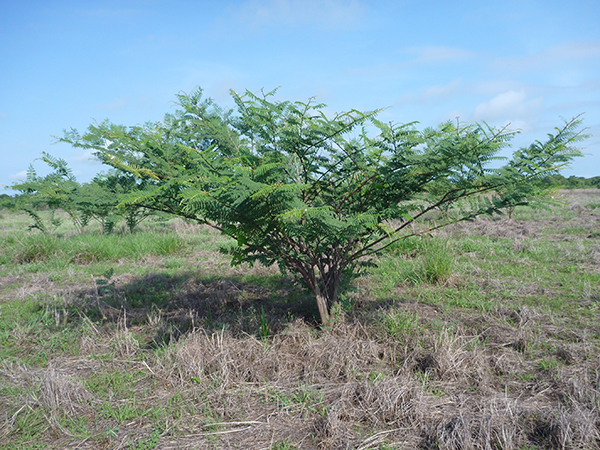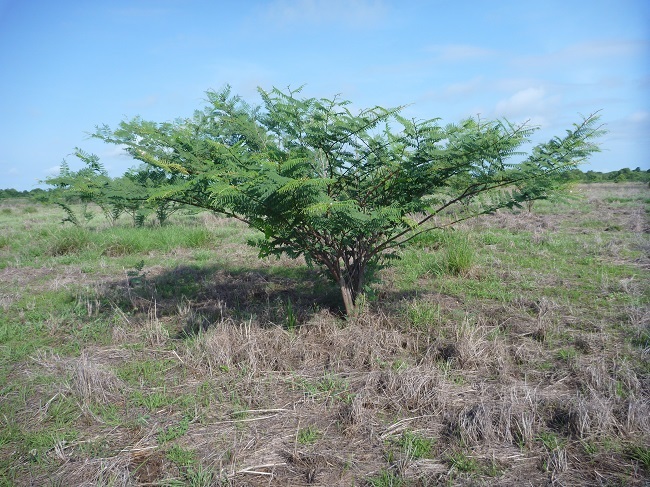Parkinsonia
Scientific name: Parkinsonia aculeata
Declaration status: Class B
Parkinsonia is a Weed of National Significance. For more information, go to the Australian Government's Department of Environment website.
Parkinsonia is native to Central and South America, Mexico and southern USA.
It may have been introduced to Australia in the late 19th century as a shade tree for planting around water bores, dams and homesteads.
It is now found in established thickets throughout semi-arid Australia with infestations in Western Australia, the Northern Territory (NT), Queensland and northern New South Wales.
Parkinsonia is well established on the Barkly Tableland, in the Victoria River district and Gulf regions and occurs in various densities across most of the NT.
It can grow in a wide range of climatic and soil conditions. Once plants are established, they can tolerate heat and drought.
Impact
Parkinsonia infests nearly one million hectares, and threatens the agricultural and environmental values of over three-quarters of the Australian mainland.
Parkinsonia can have all of the following impacts:
- creates dense, impenetrable thickets that can be several kilometres across
- restricts mustering
- blocks access to water
- displaces native plants and animals
- changes stream flows and gives shelter to feral animals, particularly pigs
- dams watercourses, causes erosion and lowers watertables in wetlands
- takes over large areas of floodplain
- threatens significant wetland areas, national parks and other regions of high aesthetic, Aboriginal and tourism value.
Identification
You should use this as a guide. There may be other plants or weeds that look similar.
- thorny, branched, spreading tree up to 6m high
- bright green branchlets in a thin zig zag pattern with sharp, woody spines along the stems
- green, drooping compound leaves
- numerous oval leaflets 1mm to 3mm long
- small, yellow flowers with five petals positioned along the stalk
- pods are green to pale brown 5cm to 10cm long with small constrictions between hard, oval seeds.
To find out more, get the parkinsonia weed note on the Department of Lands, Planning and Environment website.
If you are unsure, contact the Weed Management Branch.
Similar looking plants
The following plant species look similar to parkinsonia.
Mesquite (Prosopis spp.) is native to North and South America. Severe mesquite infestations can reduce the production of native and introduced pasture species by up to 90%.
Find out more about mesquite.
Prickly acacia (Acacia nilotica) is native to the tropics and subtropic of Africa, Pakistan, India and Myanmar. It is a thorny, umbrella-shaped single stemmed tree.
Find out more about prickly acacia.
Mimosa bush (Acacia farnesiana) is native to Central and South America. It is a rounded shrub or small tree that forms thorny thickets that hinder mustering and stock access to water. It is not a declared weed in the NT.
Mimosa (Mimosa pigra) is native to tropical America from Mexico to northern Argentina. Up to 140,000 hectares of land in the NT, 10% of the Territory's wetlands, is already impacted by mimosa.
Find out more about mimosa.
Read the what prickle bush is that? guide PDF (85.5 KB) to help you identify a prickle bush that might be parkinsonia.
Control
Chemical control
The best time to treat parkinsonia is from March to May.
Below is a list of treatment methods that can be used.
| Chemical and concentration | Rate | Situation, method and notes |
|---|---|---|
| Aminopyralid 8g/L, Triclopyr 300g/L and Picloram 100g/L Grazon® Extra | 350ml / 100L 3L / ha | Seedling (individuals and infestation): Foliar spray - avoid spraying if plants are stressed or bearing pods - Uptake spraying oil required Foliar spray - plants up to 2m or two years old - Uptake spraying oil required |
| Triclopyr 240g/L and Picloram 120g/L Access® |
1L / 60L (diesel) 1L / 60L (diesel) | Seedling or adult (individuals or infestation): Basal bark < 5cm stem diameter Cut stump > 5cm stem diameter |
| Tebuthiuron 200g/kg | 1.5g / m2 | Seedling or adult (individuals or infestation): Granulated herbicide - ground applied Do not use within 30m of desirable trees or apply to continuous area > 0.5ha Do not use if fire is eminent Apply when there is soil moisture or prior to rain |
Basal bark and cut stump treatment can be done at any time of the year.
For basal bark you need to spray around the whole stem up to 30cm from the ground.
For cut stumps make sure the plant is cut off low to the ground and chemicals are applied to the exposed surface.
Non-chemical control
Hand pulling and grubbing
Weeds, including their roots, are pulled out of the ground by hand or using hand tools.
This is an effective method of control for individual weeds and recent outbreaks that haven’t released seeds yet.
Blade ploughing
A blade plough is used to push over some woody shrubs and sever their roots underground.
Bulldozing
Bulldozers, chopper rollers or graders are used to clear large weed infestations.
This leaves large areas of soil exposed so follow up control or revegetation should be considered.
Stick raking
A large blade with teeth attached to a bulldozer is used to clear large weed infestations.
This leaves large areas of soil exposed so follow up control or revegetation should be considered.
Chaining
A large heavy chain is dragged across the ground by heavy machinery to push over and pull out large weeds.
This method is useful for removing roots and providing access for burning.
It works best at the end of the wet season when the ground is soft and roots are easier to pull from the soil.
This method has been successful in prickly acacia control where dense stands are dry or in drought.
Fire
Fire as a management technique is most effective when it is used together with other methods.
It is useful for mass seedling control if there is a sufficient fuel load.
Revegetation
Re-planting native vegetation or desirable pasture or crop species creates competition for the weeds that are present.
It is especially useful when weeds have been removed as an established desirable plant will compete with the new weed seedlings as they emerge.
Biocontrol
The parkinsonia biological control program is a collaboration between CSIRO and the Northern Territory, Queensland and Western Australian governments.
Read about biological control for more information on the parkinsonia biocontrol program.
Spread
The seed pods can float and are often carried down drainage lines and rivers for long distances.
The seeds have a thick and extremely hard coat and can stay viable in the soil for many years.
It can spread widely during flooding events and can be spread in mud sticking to machinery, animals and footwear.
Animals will often not eat the seeds, but they have been known to eat and spread seeds when there are limited choices for food, especially during drought.
Mass germination events may occur following flooding, enabling the establishment of dense thorny thickets if not controlled early.
Spread prevention
You can prevent the spread of parkinsonia by doing all of the following:
- map infestations to help develop a management plan
- control minor infestations, isolated outbreaks or seedlings first
- prioritise control along waterways, bore drains and dams to reduce spread
- always control plants upstream first
- increase community awareness to help find and control the species
- designate wash down areas and actively work to prevent contamination of clean areas
- monitor areas that you have treated and watch for re-infestations.
Give feedback about this page.
Share this page:
URL copied!
